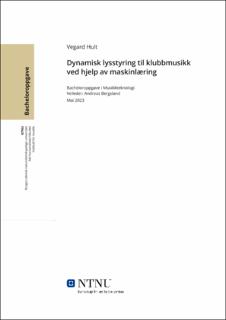Dynamisk lysstyring til klubbmusikk ved hjelp av maskinlæring
Bachelor thesis

Permanent lenke
https://hdl.handle.net/11250/3074853Utgivelsesdato
2023Metadata
Vis full innførselSamlinger
- Institutt for musikk [501]
Sammendrag
Klubbopplevelsen kan forsterkes ved hjelp av et koordinert lysshow. Det eksisterer idag flere automatiske løsninger for å synkronisere lyseffekter med musikk, men ingen av disse systemene kan følge oppbygningen i musikken på samme måte som en lystekniker med god forståelse av musikalsk oppbygning. Denne oppgaven vil utforske mulighetene for å utvikle programvare som etterlikner valgene en lystekniker tar for å følge den musikalske energien i en klubbsetting, ved hjelp av maskinlæringsalgoritmer.Programvaren var ikke funksjonell ved prosjektets slutt, og førte ikke til et resultat som kan evalueres oppimot målsettingen. Denne oppgaven er derfor heller en oppsummering av arbeidet og funnene som ble gjort underveis, og skisser til mulige løsninger for videre utvikling av programvaren. The experience of clubbing can be amplified by a coordinates light show. Multiple automatic solutions for synchronizing lighting effects with music exist today, but none of these are able to follow the energy curve of the music in the same way as a dedicated lighting technician with understanding of musical structure. This thesis explores possibilities for development of software that mimics the way a light technician adapts the lighting to fit the energy of music in a club setting, using machine learning algorithms.The software was not functional at the end of the project, and the results cannot be evaluated based on the original objective of the project. This thesis will therefore read as a summary of the process and the findings that were made along the way, and sketches for possible solutions for future developments of the software.